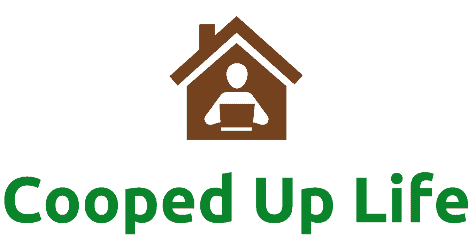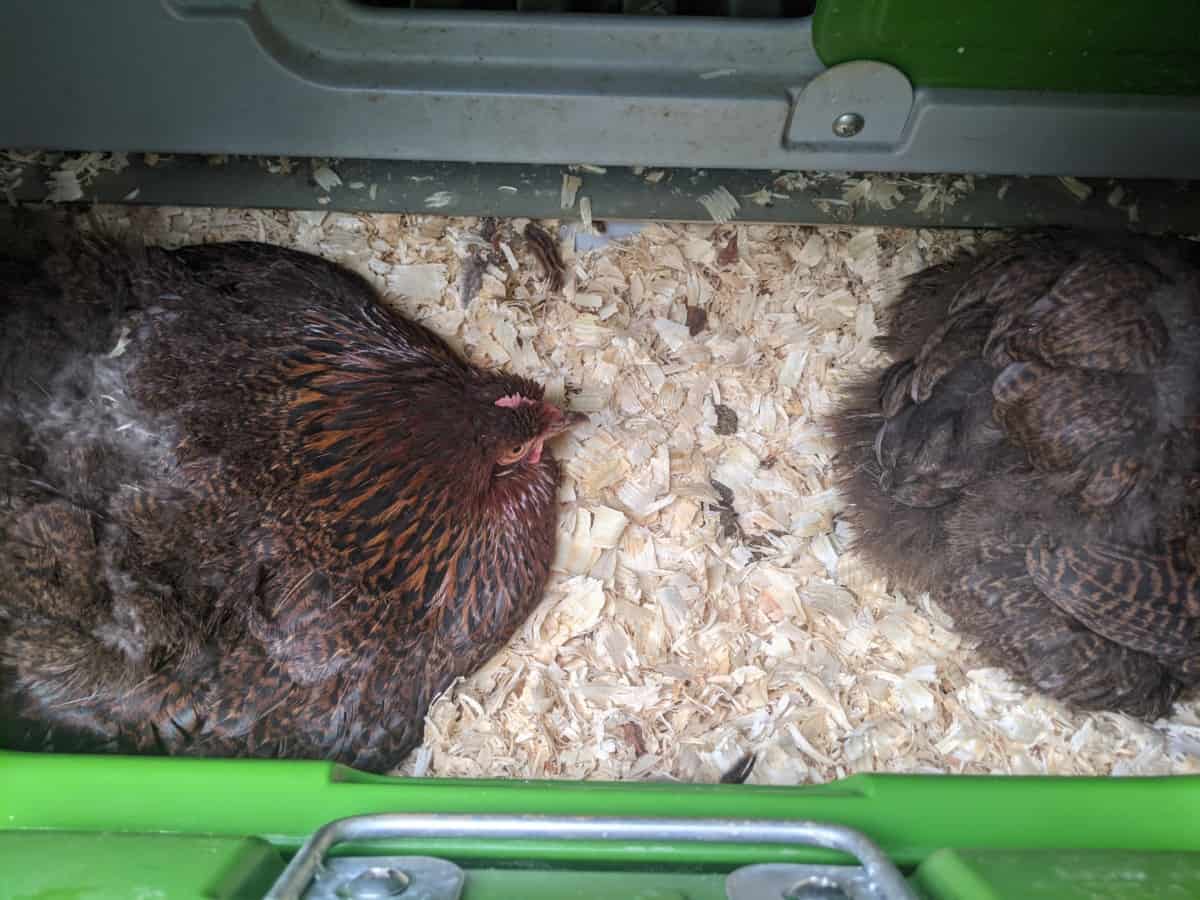You’ve got the chickens, and you’ve got the coop, now what? Now you start setting up your chicken facilities and learning how to care for your chickens. Which substrate to use as your chickens’ bedding is a significant decision in successful chicken husbandry.
The ideal chicken bedding for commercial chickens is large flake pine shavings provided by specialist suppliers. The shavings should be free of contaminants and dust. Free-range chickens not confined to an enclosed structure do best with sand floors and pine shaving beds in their nesting boxes.
The choice of bedding will affect the health of your chickens, the quality of broiler carcasses, loss rates, and the number of cracked eggs. If you are keeping chickens as a hobby, the losses will be heartbreaking. The financial implications of compromised outputs in commercial operations can be catastrophic.
The choice of bedding is a welfare issue regardless of if the motivation is financial or emotional. The bedding needs to meet all the chickens’ bedding needs and be readily available, efficient to use, and cost-effective.
The substrate used for your chickens’ bedding will make your life easier or more challenging, so choose wisely!
What is Chicken Bedding, And Why Is It Important?
Chicken bedding is any type of removable substrate placed onto the floor of the chicken’s house or outdoor shelter. Bedding often becomes mixed with chicken excrement (urine and feces), feathers, and spilled chicken feed.
This mixture forms the basis of agriculture poultry litter. Poultry litter is used as a nutrient-dense fertilizer or alternative fuel source.
Different Types of Chicken Bedding
There are many different types of bedding substrates to choose from. It can be overwhelming to decide which bedding would suit you and your chickens.
Before discussing the advantages and disadvantages of each type of bedding substrate, we will first investigate what qualities the ideal bedding should have. In essence, this is a marking rubric for a bedding substrate.

Criteria For The Ideal Bedding Substrate For Chickens
- Medium-sized soft particles: If the particles are much larger than this, there is a risk of the bedding hurting the chickens’ feet. If the particles are much smaller than this, dust can occur. Excessive dust can cause you and your chickens to struggle with eye infections and respiratory difficulties.
- Excellent absorbency and fast drying: The bedding will fail the criteria for the ideal bedding if the chickens’ excrement sits on top of the bedding without being absorbed. Non-absorbent bedding would behave in the same way as a concrete or wooden floor, making its placement in the coop useless. Thus non-absorbent rubber chips are inadequate as a bedding substrate. Of equal importance to absorbency is the ability of the bedding to dry quickly. Damp, non-drying areas of bedding are perfect for nurturing mold or fungal infestation; an undesirable outcome!
- Free of contaminants, i.e., Glass, toxins, metal, or other foreign bodies that pose a risk to you or your chickens. Bedding materials obtained from farms or factories may have pesticides that are harmful to your chickens. Glass and metal can cut and injure your chickens or yourself.
- Light and easy to manage: Chickens go through a lot of bedding each day! Moving the wet and dry bedding into and out of the coop and turning the bedding over is back-breaking work. Speaking on behalf of your back, please choose lightweight bedding that doesn’t cake or form clumps.
- Good insulation and cushioning properties: Chicks are susceptible to cold and quickly die when temperatures drop. Most chicken farmers maintain the coop’s interior temperature with various electrical warming and heating elements. Bedding with good insulation properties will allow you to reduce your electricity costs while still maintaining an optimal temperature. Broilers grow rapidly, and their legs suffer for the speed and size of the growth. Foot sores and skin blisters are common in overlarge broilers. Bedding that provides adequate cushioning for these birds will help alleviate some of these injuries.
- Cheap and Available: There is absolutely no point in identifying the perfect bedding substrate and discovering it’s only available in Europe or China. Of equal relevance is the cost of the bedding. Chickens use a surprising amount of bedding each week, and the dollar signs can quickly rack up to a knee-weakening amount. So cost-effective options will always be the preferred substrate for bedding.
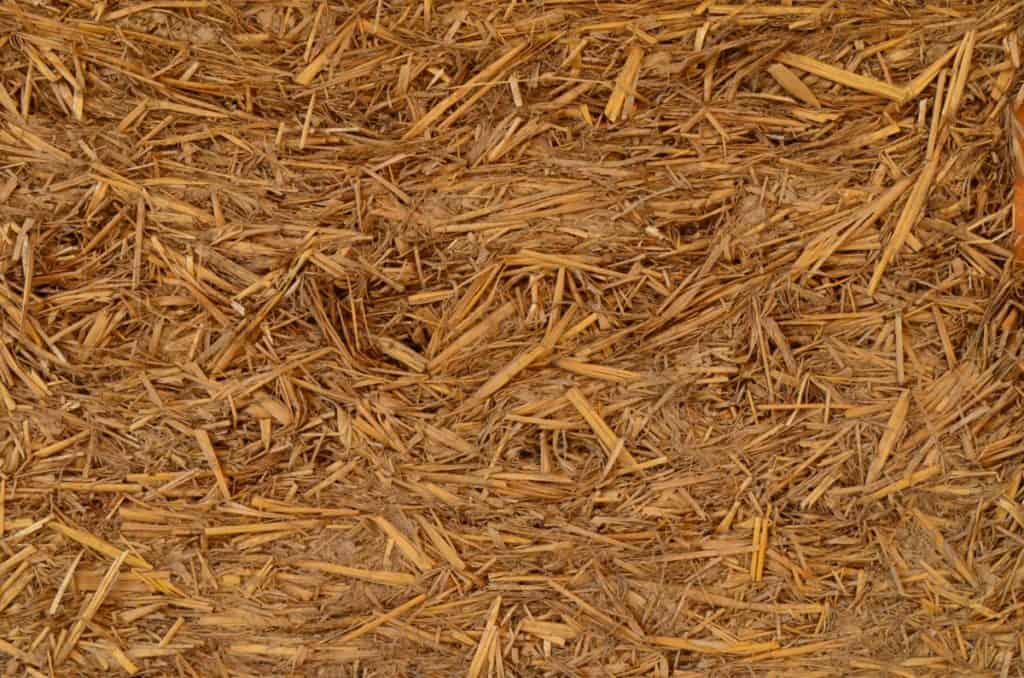
Straw And Hay Bedding For Chickens
There is a rustic appeal to using straw. Almost all old-time farm yards would have the requisite broody hen sitting nestled in a nest of straw. As picturesque as this is, the straw the farmers initially provided for their chickens was surplus bedding from the horse and cow barns.
Straw is not ideal for either free-range hobbyist flocks or commercial chickens. Straw has very poor absorbency and allows puddles of urine and other fluids to leak through and accumulate on the coop floor.
These stagnant bacteria-rich puddles are the perfect spot to grow mold and fungi! Mold can cause chickens to develop a respiratory condition call aspergillosis.
When wet, long strands of straw can become tangled and matted, creating an immovable mass of excrement and decomposing straw. It is unwieldy and wildly unpleasant to shake out or replace an old straw bedding.
In recent years, chicken fanciers have identified a disturbing trend. Although straw does not taste good, a few enterprising chickens invariably try to eat the straw. Straw particles do not pass easily through a chicken’s crop, and many chickens die due to straw impaction in the crop.
Straw has a few advantages; it is typically cheap, readily available, and looks pretty when new.
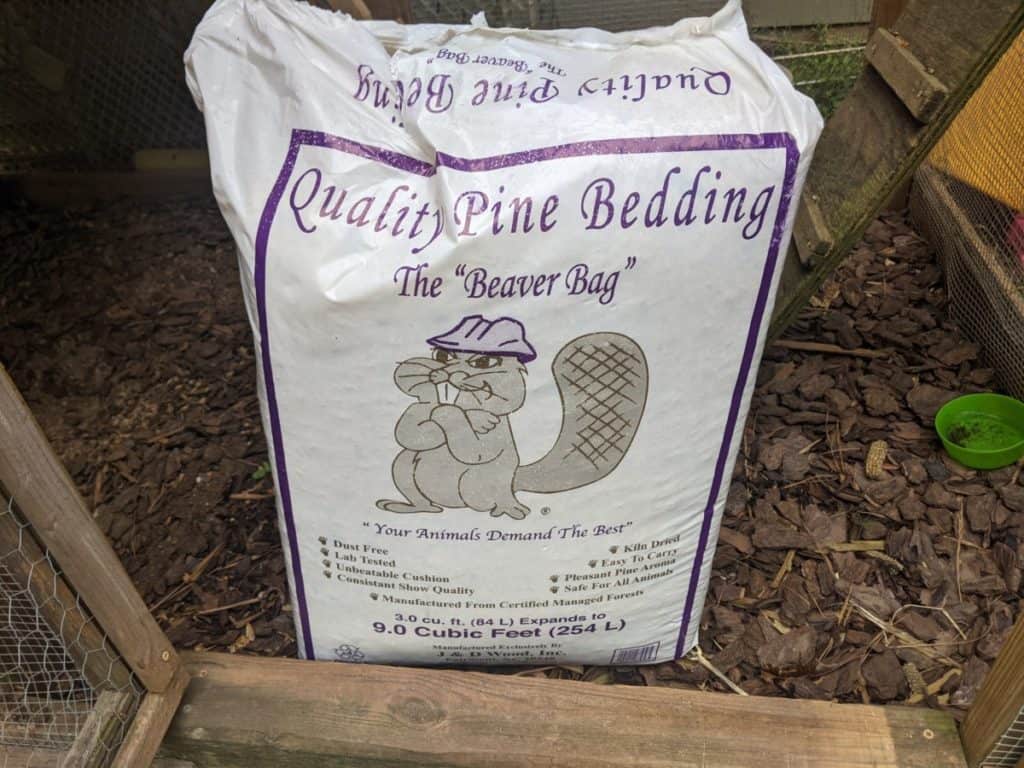
Wood Shavings Bedding For Chickens
Pine shavings are one of the most widely used substrates in chicken bedding. It has excellent absorbency and dries quickly, reducing the amount of stagnant liquid pools and aiding in odor control. The comfy wood shavings provide outstanding cushioning for delicate chickens as well as having excellent insulation properties.
Wood shavings are widely available, and although they tend to be more expensive than straw, they are still relatively cheap.
There are a few precautions to follow when buying wood shavings. Firstly, not all woods are safe for chickens. Cedar is toxic to chickens. It contains cedrene which irritates the bird’s respiratory system. In extreme cases, cedar poisoning can cause respiratory failure and death.
It is essential to know how and what the wood was treated with before being shaved. Drying the wood before shaving reduces the moisture content of the shavings, increasing absorbency and decreasing the risk of mold. Timber is often treated with products intended to preserve them.
For example, creosote is commonly used to improve the longevity of outdoor wooden structures. Creosote contains arsenic which is poisonous to chickens if ingested or inhaled. A supplier specializing in wood shavings for chickens may be more expensive. Still, at least you know the product they supply is safe for your chickens.
Lastly, the size of the wood flakes is essential. Small chips easily crumble into dust particles, leading to eye and respiratory issues for both you and your chickens. The best bedding for chickens, particularly commercial broilers and layers, is large flake wood shavings.
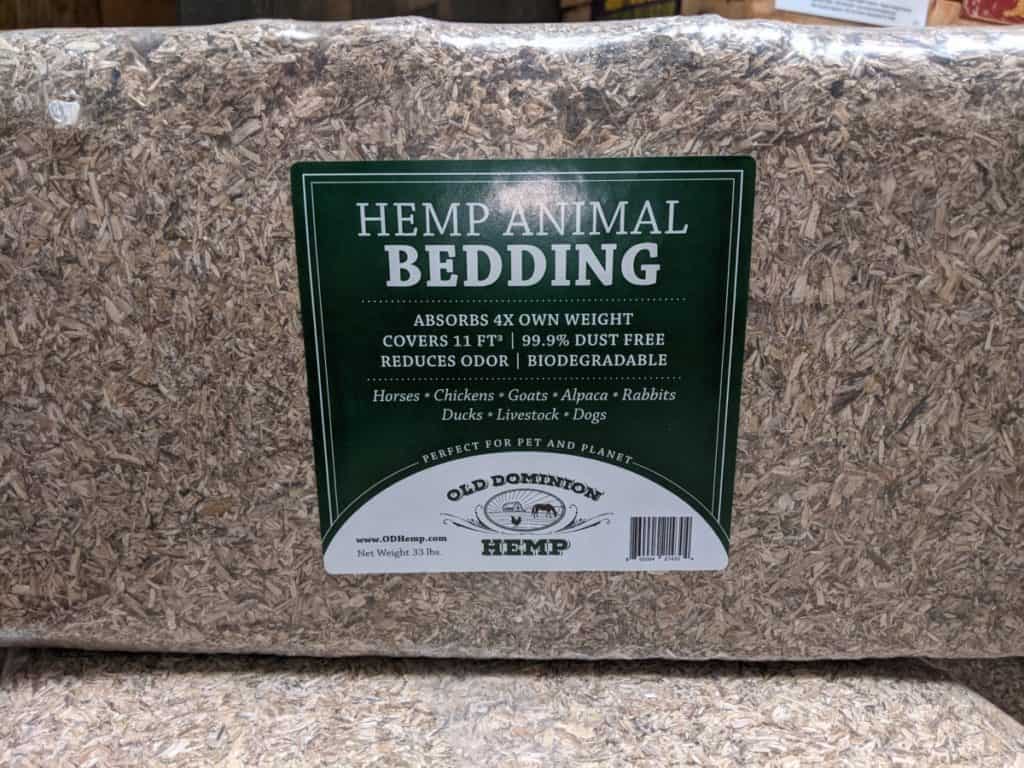
Hemp Bedding For Chickens
Hemp can also be used as a creative and effective bedding option for chicken coops, even though it’s not yet readily available in every local feed store.
The “hurd” of the hemp plant is what is used for this type of bedding. Hurds are the inner woody stalk of plants that are then mulched into straw-like bedding. It’s less dusty, more absorbent than pine shavings and straw, and still maintains the same clean-up efficiency as the other beddings. Another nice benefit is that breaks down faster in compost bins than other bedding materials.
Next time your at your local feed store you may want to give it a try.
Shredded Newspaper Bedding For Chickens
Shredded paper is a viable alternative for owners who struggle with dust allergies. The large flakes of paper do not break down like wood shavings, and so the dust is minimal. Most recycling companies do not want to accept shredded paper.
Law firms and other professions handling sensitive information often generate large amounts of shredded paper waste, which they will gladly give away for free. New dry paper bedding provides acceptable cushioning, although it is not as effective as wood shavings.
However, before you start celebrating, we need to look at the dark side of paper bedding. Paper bedding has excellent absorbency up to a point. Wet paper can be incredibly slick and slippery to walk on. Both you and the chickens might end up slip-sliding all over the place!
Once the damp paper begins to dry, it clumps together and hardens. You are essentially forming Papier Mache sculptures in your chickens’ bedding. Once this has occurred, the bedding needs to be replaced. Using shredded paper as chicken bedding is incredibly labor-intensive. The paper bedding will need to be changed every 2-4 days.
Some chicken fanciers have raised concerns that the ink contained within the paper may be harmful to chickens. Many of them have witnessed their chickens making unwise life choices and eating the paper. If you possess a chicken or chickens who are indiscriminate eaters, it would be best to avoid shredded paper beds.
Compacted Earth And Sand
Sand most closely resembles the natural footing that chickens thrive on. Although the sand offers minimal cushioning benefits, it does not cause foot sores, breast blisters, or other mechanical injuries associated with hard floors.
Sand’s absorbency is excellent, and when wet forms convenient clumps which can be picked up and removed. Sand bedding lends itself well to a deep litter maintenance plan. With deep litter, a thin layer of bedding is added. Once that layer becomes soiled, it is turned (the dirt stuff moved to the bottom), and a fresh ned layer is spread along the top of the bedding.
Gradually the bedding becomes deeper and deeper. Once it is about a foot deep, all the old bedding is removed and incorporated into compost heaps. The deep litter process starts again.
Critiques claim that failure to remove all excrement increases the risk of health issues and provides inadequate odor control. Proponents of this method claim the opposite.
In my experience, sand is perfect for SMALL FREE-RANGE flocks. It’s vital when using sand bedding that the birds are provided with deeply padded comfortable nesting boxes; the ideal bedding for nesting boxes in large flake pine shavings.
Comparison Of Different Bedding Substrates
| Straw & Hay | Wood Shavings | Shredded Newspaper | Compacted Earth & Sand | |
| Medium-sized soft particles | Hard strands | Soft large flakes are best. Small chips can be dusty. | Excellent | Tiny sand particles – can be dusty |
| Absorbency & fast drying | Poor absorbency | Excellent | Initially good but quickly becomes unusable | Good |
| Light & easy to manage | Unwieldy went wet & clumped | Good | Good | It forms small clumps which are easy to remove |
| Contaminates | Pesticides | Purpose produced wood shavings don’t contain contaminants | Ink | No |
| Insulating & cushioning | Poor | Excellent | Adequate | Poor |
| Cost & availability | Cheap & readily available | Cheap-mid price range & easily available | Usually Free & easily available | Free & readily available |
Conclusion
Choosing a bedding substrate for your chickens’ coop will significantly impact your chicken-keeping experience. Different bedding substrates have varying advantages and disadvantages.
However, most chicken hobbyists and farmers agree that chicken-specific pine shavings are the ultimate coop bedding. These large-flake pine shavings are free of contaminants and dust, offering superior absorbency, cushioning, and insulation. Pine shavings are a cost-effective, easy-to-use substrate.
